History of the PSQ
In 1921, six people attended the first meeting of the Queensland Philatelic Society which was believed to have been held in the YMCA rooms in Edward Street in Brisbane’s CBD. Mr. Saville Hodge Sheard was elected as the first president, and he went on to hold the position for nineteen of the next twenty-eight years. His name lives on through the Sheard Medal which is still competed for to this day. Read more about the Sheard Medal on the Exhibitions Page. There is a link to the Exhibitions Page at the bottom of this page. Here is the Society’s first constitution.

Annual subscriptions were set at 10/- for senior members. People who lived more than 25 miles from the Brisbane GPO were classed as country members so paid 7/6, while juniors (under 18) paid 5/-. These were considerable sums in those days – the equivalent of more than double the subscriptions in the 2020s.
Circuit Books were started, and as the Society had no permanent rooms at that time, the books were left for safe keeping with a member, a solicitor who had offices around the corner in George Street.
A year later, there were approaching one hundred members and bi-monthly meetings were held at the Metropolitan Building, Albert Square.
The Society’s Committee Members for 1922 and 1923 are shown below. This comes from the collection of Mr. Percy Howard Wilbraham, top centre, as does the image of the 1920 constitution above and that of a ticket (below) for a Society outing on the Brisbane River in March 1922. It is believed that the original discussions to form the Society had been held at Mr. Wilbraham’s residence at 10 Albert St. Woolloongabba.


The Society began publishing a journal, the “Queensland Philatelic Review” but the name was soon changed to “Australian Philatelic Review”, presumably to broaden its appeal. In 1926, the “Australian Philatelic Review” became a quarterly publication but soon after publication ceased, seemingly because it was not covering its own costs.
In 1923, the Metropolitan Building was demolished to make way for the city hall building. (Albert Square later became King George Square). Meetings were held in the solicitor member’s chambers and various cafes in the CBD until a more permanent home was found in Albert House, Ann Street. By 1924, philately was so popular that the Society’s rooms were open to members every day. For some years, the QPS was the only stamp society in Queensland, which may have accounted for the high membership.
In 1935, the “Australian Stamp Journal” reported that members of the Queensland Philatelic Society voted to write to the Postmaster General to protest the high value of commemorative stamps, on the basis that ordinary members of the public would never have the need to use them. This meant that they would rarely be found in used condition, so they were a waste of printer’s ink. The Postmaster General’s response, if there was one, is not known.
Not surprisingly, during the war years membership dwindled but even so, in 1944 a decision was made to form a Queensland Stamp Collection for display at the Oxley Memorial Library. One member, Captain Donaldson, donated his personal collection of Queensland stamps and other members also contributed.
By 1948, people were returning to their hobbies and membership numbers had recovered to the highest ever, around two hundred. The high membership was partly due to the circuit books which were circulated amongst members all over Queensland, as well as interstate. Forty-five to fifty members regularly attended meetings, though the minutes of one meeting documented a record attendance of fifty-seven.
Meetings were held at the Builders Exchange on Wharf Street for several decades, though confusingly some records state “Builders Exchange, Creek Street”. Many years later, the mystery was solved when a member reported that as junior member, he had attended meetings at the Builders Exchange – and it was on Wharf Street.
In the mid 1970s, when subscriptions no longer covered the high overheads in the CBD, the Society moved to St. Peters Church Hall, Lutwyche. The move from the city saw a radical improvement in both member numbers and attendance at meetings. Meetings were held at Lutwyche for about two years before relocating to the Uniting Church Hall in Windsor in 1977. With extra cupboard space available at the Uniting Hall, the Society was able to store its library there. For several years, it had been held at the home of a member for safe keeping.
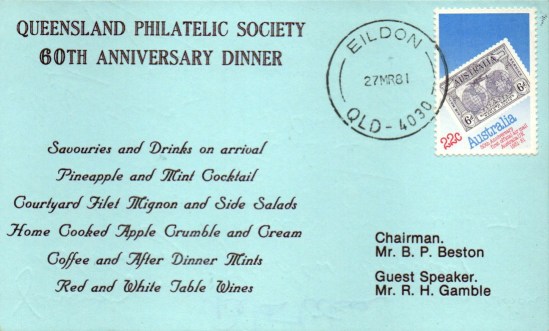
In 1981, the Society celebrated its 60th Anniversary with dinner at a restaurant in Bowen Hills. Fifty-two members, representatives of other stamp clubs, and several local stamp dealers attended, and one hundred commemorative covers were cancelled at the Eildon Post Office on the day of the dinner.
Mr. R.H. Gamble, the Manager of Stamps and Philatelic Services at Australia Post, gave a talk and slide show entitled “Birth of a Stamp” which covered the process from design to the finished article. One notable attendee was Arch Stoney, who had been a very active member for over fifty years. The Immediate Past President, Bernard Beston, was chairman for the dinner. Interestingly, Mr. Beston was the member who had been able to clear up the confusion over the Wharf Street/Creek Street address.

In 1981, the Society celebrated its 60th Anniversary with dinner at a restaurant in Bowen Hills. Fifty-two members, representatives of other stamp clubs, and several local stamp dealers attended, and one hundred commemorative covers were cancelled at the Eildon Post Office on the day of the dinner.
Mr. R.H. Gamble, the Manager of Stamps and Philatelic Services at Australia Post, gave a talk and slide show entitled “Birth of a Stamp” which covered the process from design to the finished article. One notable attendee was Arch Stoney, who had been a very active member for over fifty years. The Immediate Past President, Bernard Beston, was chairman for the dinner. Interestingly, Mr. Beston was the member who had been able to clear up the confusion over the Wharf Street/Creek Street address.
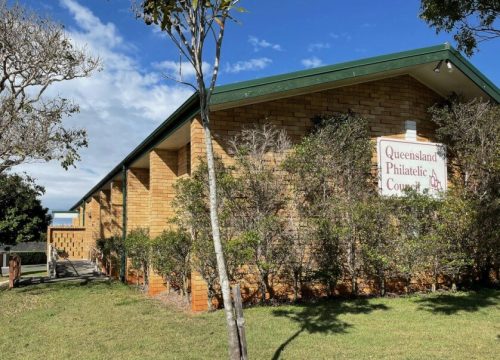
The Queensland Philatelic Society remained in Windsor until 1988 when the final move was made its current home in QPC House, Wynnum, a coastal suburb on Brisbane’s south side.
The Queensland Philatelic Society remained in Windsor until 1988 when the final move was made its current home in QPC House, Wynnum, a coastal suburb on Brisbane’s south side.

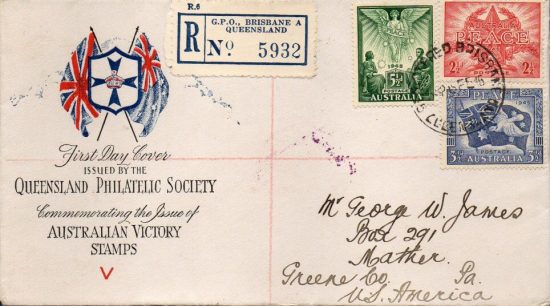

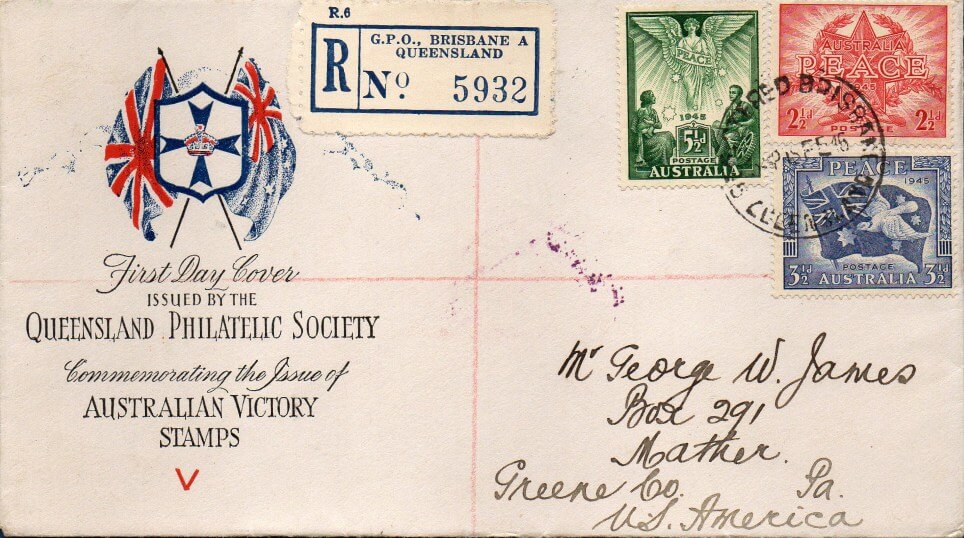

A previously unknown commemorative cover issued by the Queensland Philatelic Society, known as the 1946 Peace Cover, was discovered in a box at a stamp fair in England in 1992. A victory issue and its production were mentioned in the minutes of a Society meeting In October 1945, but no other details are known.
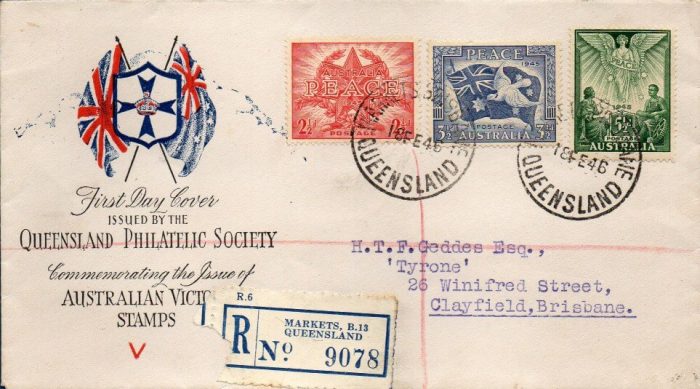
Two more covers were found in England, which suggests that it might have been mostly sent overseas, though one to a local Brisbane address, registered at Brisbane Markets, later came to light.
In 1994, the name was changed from “Queensland Philatelic Society” to “Philatelic Society of Queensland” (PSQ) to a avoid confusion with the “Queensland Philatelic Council”. In this year, the Society celebrated the 100th birthday of Arch Stoney, by which time Mr. Stoney had been a member for sixty-four years. Sadly, he died just six weeks later.
Also in 1994, the Philatelic Society of Queensland held the first Open Day at its home, QPC House in Wynnum. Open Days have been held in the Wynnum area since then.
The Society won the Thomas Trophy five times over twenty-five years. This was a competition for Clubs or Societies, awarded for twelve sheets supplied by three different members. The twist was that it was judged by three non-philatelists. Since the Queensland Interclub Trophy replaced the Thomas Trophy, the Society has won a further three times, in 2013, 2017 and again in 2022.
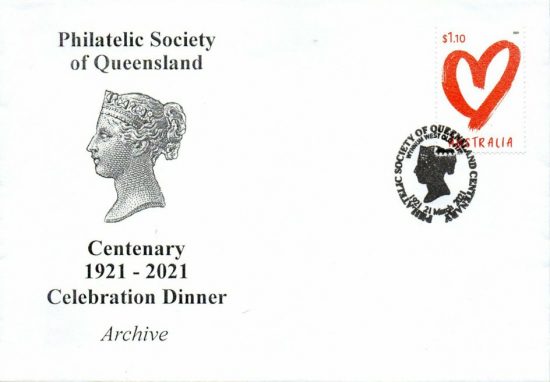
On 20th March 2021, the Philatelic Society of Queensland celebrated its one hundredth anniversary with a dinner at the Waterloo Bay Hotel, attended by twenty-six members, their wives, and partners. A Commemorative Cover, with a special temporary cancellation from the Wynnum Plaza Post Office, dated 21st March was given to attendees.
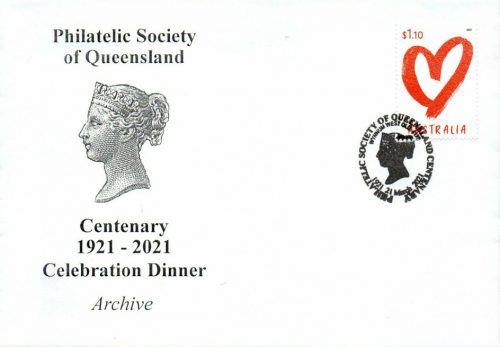
On 20th March 2021, the Philatelic Society of Queensland celebrated its one hundredth anniversary with a dinner at the Waterloo Bay Hotel, attended by twenty-six members, their wives, and partners. A Commemorative Cover, with a special temporary cancellation from the Wynnum Plaza Post Office, dated 21st March was given to attendees.
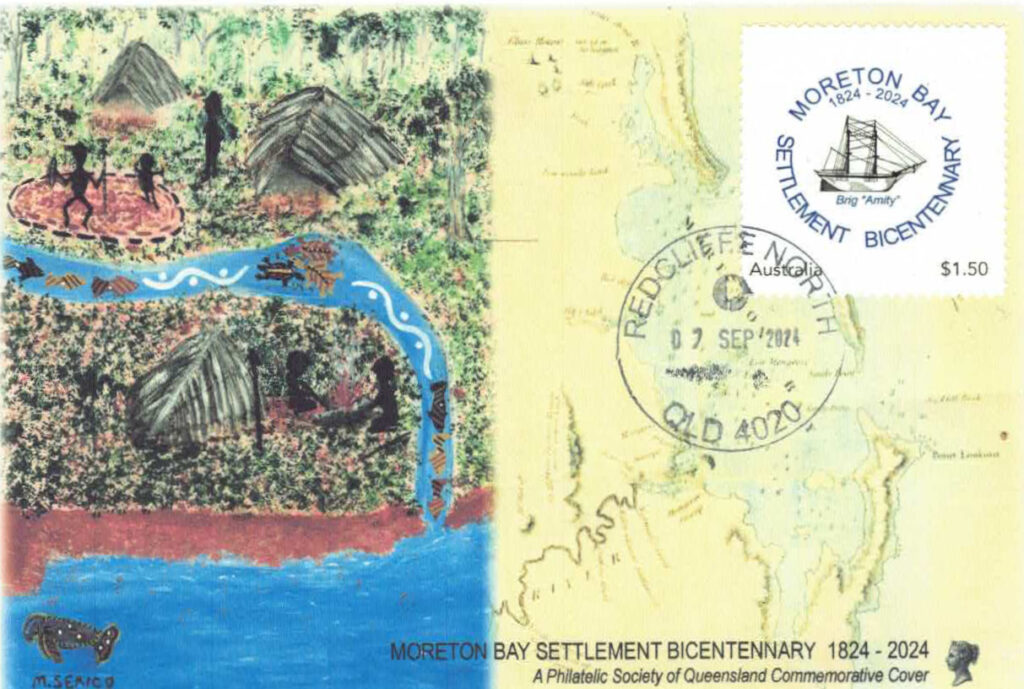
On 7th September 2024, the Philatelic Society of Queensland contributed to the Wunya Ngulum conference at the Komo Hotel in Redcliffe, Qld, to commemorate the 200th Anniversary of the establishment of the Moreton Bay penal colony in 1824. This was the first British settlement established in Queensland. The original settlement was close to the venue. The conference was part of the commemoration of Queensland’s Bi-Centennial and was organised by the Royal Historical Society of Queensland, History Redcliffe and the Bribie Island Historical Society. Three PSQ members kindly produced the commemorative cover shown here, and each conference attendee received a copy. The cover features a beautiful painting by Melinda Serico, and a contemporary map of the Settlement area. It bears the Society’s name and has a special stamp produced by the PSQ members showing the Brig Amity, the vessel that brought the new arrivals from Sydney to Moreton Bay. PSQ is proud to be part of commemorating Queensland’s history and heritage.

On 7th September 2024, the Philatelic Society of Queensland contributed to the Wunya Ngulum conference at the Komo Hotel in Redcliffe, Qld, to commemorate the 200th Anniversary of the establishment of the Moreton Bay penal colony in 1824. This was the first British settlement established in Queensland. The original settlement was close to the venue. The conference was part of the commemoration of Queensland’s Bi-Centennial and was organised by the Royal Historical Society of Queensland, History Redcliffe and the Bribie Island Historical Society. Three PSQ members kindly produced the commemorative cover shown here, and each conference attendee received a copy. The cover features a beautiful painting by Melissa Serico, and a contemporary map of the Settlement area. It bears the Society’s name and has a special stamp produced by the PSQ members showing the Brig Amity, the vessel that brought the new arrivals from Sydney to Moreton Bay. PSQ is proud to be part of celebrating Queensland’s history and heritage.

On 7th September 2024, the Philatelic Society of Queensland contributed to the Wunya Ngulum conference at the Komo Hotel in Redcliffe, Qld, to commemorate the 200th Anniversary of the establishment of the Moreton Bay penal colony in 1824. This was the first British settlement established in Queensland. The original settlement was close to the venue. The conference was part of the commemoration of Queensland’s Bi-Centennial and was organised by the Royal Historical Society of Queensland, History Redcliffe and the Bribie Island Historical Society. Three PSQ members kindly produced the commemorative cover shown here, and each conference attendee received a copy. The cover features a beautiful painting by Melissa Serico, and a contemporary map of the Settlement area. It bears the Society’s name and has a special stamp produced by the PSQ members showing the Brig Amity, the vessel that brought the new arrivals from Sydney to Moreton Bay. PSQ is proud to be part of celebrating Queensland’s history and heritage.
The Philatelic Society of Queensland continues to hold meetings on the fourth Wednesday of the month, a tradition established back in 1937.














